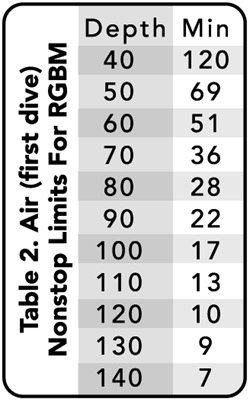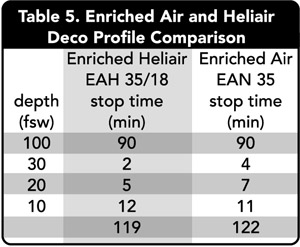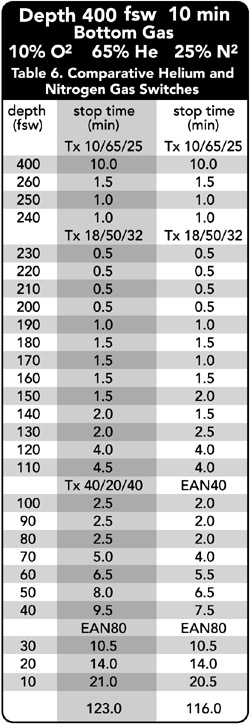|
| |
|
 |
|
|
By B.R. Wienke and T.R. O’Leary
NAUI Technical Diving Operations |
| Excerpt from ADM Issue 14, 2006 |
The RGBM grew from needs of technical divers to more efficiently stage ascents consistent with coarse grain dissolved gas and bubble dynamics, and not just dissolved gas (Haldane) constraints. And the depth, diversity, mix variation, and self consistency of RGBM diving applicability has satisfied that need. And safely.
The RGBM has gained tremendous popularity in the recreational and technical diving worlds in just the past 2 - 3 years, due to meter implementations, Internet software packages, specialized Table releases, technical word of mouth, NAUI training testing and adoption, Internet traffic, chamber tests, and, most of all, actual technical and recreational RGBM diving and validation. And the reasons are fairly clear.
Present notions of nucleations and bubbles suggest that decompression phase separation is random, yet highly probable, in body tissue. Once established, a gaseous phase will further grow by acquiring gas from adjacent saturated tissue, according to the strength of the free-dissolved gradient. Although exchange mechanisms are better understood, nucleation and stabilization mechanisms remain less so, and calculationally elusive. But even with a paucity of knowledge, many feel that existing practices and recent studies on bubbles and nuclei shed considerable light ongrowth and elimination processes, and time scales. Their consistency with underlying physical principles suggest directions for table and meter modeling, beyond parameter fitting and extrapolation techniques. Recovering dissolved gas algorithms for short exposure times, phase models link to bubble mechanics and critical volume trigger points. The RGBM incorporates all of the above in all implementations, and additionally supports the efficacy of recently suggested safe diving practices, by simple virtue of its dual phase mechanics:
• reduced nonstop time limits;
• safety stops (or shallow swimming ascents) in the 10-20 fsw zone;
• ascent rates not exceeding 30 fsw=min;
• restricted repetitive exposures, particularly beyond 100 fsw,
• restricted reverse profile and deep spike diving;
• restricted multi day activity;
• smooth coalescence of bounce and saturation limit points;
• consistent diving protocols for altitude;
• deep stops for decompression, extended range, and mixed gas diving with overall shorter decompression times, particularly for the shallow zone;
• use of helium rich mixtures for technical diving, with shallower isobaric switches to nitrox than suggested by Haldane strategies;
• use of pure oxygen in the shallow zone to eliminate both dissolved and bubble inert gases.
Bubble models tend to be consistent with the utilitarian measures detailed above, and have the right signatures for diving applications across the full spectrum of activities. Or, said another way, bubble models are more powerful, more correct, and more inclusive. In terms of RGBM implementations, the mechanistic of dissolved gas buildup and elimination, inert gas diffusion across bubble interfaces, bubble excitation and elimination persistence time scales of minutes to hours from tissue friction, lipid and aqueous surfactant material properties, and Boyle expansion and contraction under ambient pressure change, are sufficient to address all of the above considerations.
|
|
|
|
|
STAGING AND RGBM COMPARISONS
Here, we comparatively look at the coarse bases of both meter and diveware implementations of the RGBM algorithm, one with extended range of applicability based on simple dual phase principles. Haldane approaches have dominated decompression algorithms for a very long time, and the RGBM has been long in coming on the commercial scene. With recent technical diving interest in deep stop modeling, and concerns with repetitive diving in the recreational community, phase modeling is timely and pertinent.
Nonstop Comparisons
So, the first question is how does the RGBM compare with classical Haldane models as far as staging ascents, limiting multiexposures, and treating mixed gases? Generally, for short nonstop air diving, the RGBM reproduces the Spencer limits. For multidiving in spans shorter than 1-3 hr, the RGBM reduces nonstop limits by 10% to 20% depending on surface interval, depth, altitude, and duration of present and previous dive, Multiday diving is impacted to lesser degree. Some comparisons appear in Table 1 for 3 days of repetitive air diving (120 fsw/10 min twice a day with 45 min surface interval). Computer choices are illustrative, not indictive. |
|
|
|
|
Table 2
Lists nonstop time limits for RGBM (first dive).
Table 3
Lists nonstop time limits for ranged trimix, that is, 13% to 17% helium, 61% to 53% nitrogen, and 26% to 30% oxygen, according to RGBM and ZHL (Buhlmann).
|
|
 |
 |
|
|
|
These limits are used by NAUI Technical Diving for training purposes. While both sets of nonstop time limits are different in Tables 1 and 3, the more dramatic effects of the RGBM show up for deep staging, as seen in
Table 4.
Deep Comparisons
Comparative deep schedules for a trimix dive to 250fsw for 30 min are contrasted, following a switch to air at 100 fsw and a switch to pureoxygen at 20 fsw on the way up. RGBM and ZHL are again employed, but with and without conservative safety knobs. In the case of ZHL, the outgassing tissue halftimes are increased by 1.5 in the conservative case, while for RGBM the bubble excitation radius is increased by 1.2 for comparison. Deeper stops are noticeably requisite in RGBM, but total decompression times are less than ZHL. The trimix is 33% helium, 51% nitrogen, and 16% oxygen.
|
|
 |
|
|
|
Helium Comparisons
On most counts, helium appears superior to nitrogen as a diving gas. Helium bubbles are smaller, helium diffuses in and out of tissue and blood faster, helium is less narcotic, divers feel better when they leave the water after diving on helium, and helium minimum bends depths are greater than nitrogen minimum bends depths. |
|
|
|
Table 5
A comparison of enriched air and enriched heliair decompression diving, with a switch to 80% oxygen at 20 fsw. Dive is 100 fsw for 90 min, on EAN 35 O2 and EAH 35 O2/18 HE (nitrox 35/65 and trimix 35/18/47), so oxygen enrichment is the same. The decompression profile is listed Table 5. Descent and ascent rates are 75 fsw/min and 25 fsw/min.
Overall the enriched heliair decompression schedule for the dive is shorter than for the enriched air. As the helium content goes up, the decompression advantage for enriched heliair increases. |
|
 |
|
|
|
 |
|
This may surprise you. But either way, now check out corresponding USN or ZHL decompression requirements for these dives. In the enriched heliair case, ZHL decompression time is 39 min versus 19 min above, and in the enriched air case, ZHL decompression time is 33 min versus 22 min above. This not only underscores helium versus nitrogen misfact in staging, but also points out significant differences in modern algorithms versus Haldane. Lastly consider a deep trimix dive with multiple switches on the way up.
Table 6
Contrasts stop times for two gas choices at the 100 fsw switch. The dive is a short 10 min at 400 fsw on 10/65/25 trimix, with switches at 235 fsw, 100 fsw, and 30 fsw. Descent and ascent rates are 75 fsw/min and 25 fsw/min. Obviously, there are many other choices for switch depths, mixtures, and strategies. Below, the oxygen fractions were the same in all mixes, at all switches. Differences between nitrogen or helium, even for this short exposure, are nominal. Such usually is the case when oxygen fraction is held constant in helium or nitrogen mixes at the switch.
Gradient Factor Comparisons
It is also of interest to compare RGBM profiles against other strategies, particularly modern ones. An interesting comparison is seen in Tables 7, 8, and 9, contrasting decompression protocols for the RGBM with those of the Global Underwater Explorers (GUE) DPlan, a decompression planner offering ZHL gradient factor (GF) modifications, Haldane deep stops, and hybrids. The extent of validation of the DPlan models is unknown here. The gradient factor method, or juxtaposing of arbitrary multiplicative factors to Haldane gradients, G = M - P, has also been used by DPlan to induce deep stops on Haldane staging. Simple amplification of G in the deep zones will accomplish this |
|
|
|
Table 7
15/55 trimix (15% oxygen, 55% helium, rest nitrogen) dive to 250 fsw for 30 min. Descent rate is 99 fsw/min, and ascent rate is 33 fsw/min. A switch is made to EAN50 (50% nitrogen, 50% oxygen) at 70 fsw, and a final switch to pure oxygen is made at 20 fsw.
Down to the first switch onto EAN50, both models track roughly the same. After that, the DPlan calculation requires increasingly more decompression time as the stop depth decreases. This generally occurs when deep stops are juxtaposed onto Haldane staging. Time at depth incurs more decompression time in the shallow zone. This does not occur in the RGBM.
Straightforward application of ad hoc gradient factors to the DPlan profiles in the deep zone can induce the deep stops shown. In the shallow zone, DPlan decompression times are more in step with conventional Haldane staging, that is, no gradient factor application and reduction of decompression times. Of course, in the shallow zone, gradient factors would need to be larger than one to reduce decompression times artificially over Haldane computed values. Gradient factors are neither model nor internally consistent and can be tweaked to fit any arbitrary profile after the fact.
|
|
 |
|
|
|
The gradient factor, , is applied to the (Haldane) fixed gradient, G, with resulting critical tension, M, as before. M = G + P for P ambient pressure. As gets large, or is increased beyond 1, the required stop depth drops below the depth required for classical Haldane staging. Hence, a deep stop is imposed on the profile. Roughly in applications, 0:40< < 1:40 Though utilitarian to some, this begs the question of consistency and reproducibility across a spectrum of diving activities.
To most of us in the technical and recreational diving worlds, the bottom line is simple. What works works, and what doesn’t is discarded. RGBM works. It incorporates deep stops naturally, underscores the use of helium rich breathing mixtures, and has been tried and tested in the field with many tens-of-thousands of dives by seasoned divers and raw neophytes. Tables, software, meters have incorporated the RGBM. And the RGBM data bank (RGBMdiving.com) has been constructed to store technical mixed gas, deco, and extended range profiles for model tuning, statistical reporting and risk analysis. Without doubt, the RGBM has reshaped decompression horizons and will continue to do so in the future. |
|
 |
|
|
|
|
|
|
|
|
|
|
|
| |
|